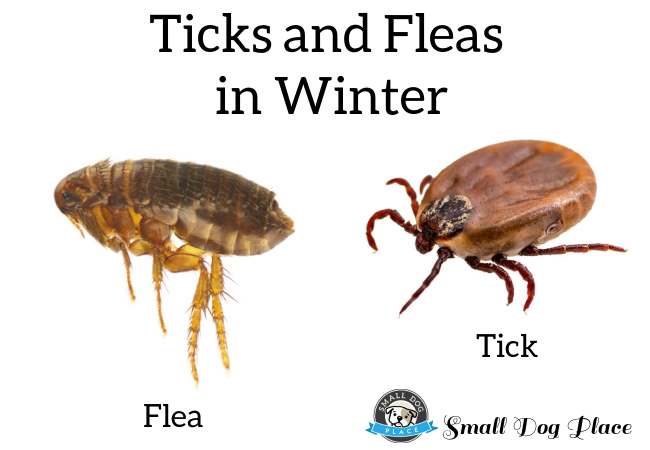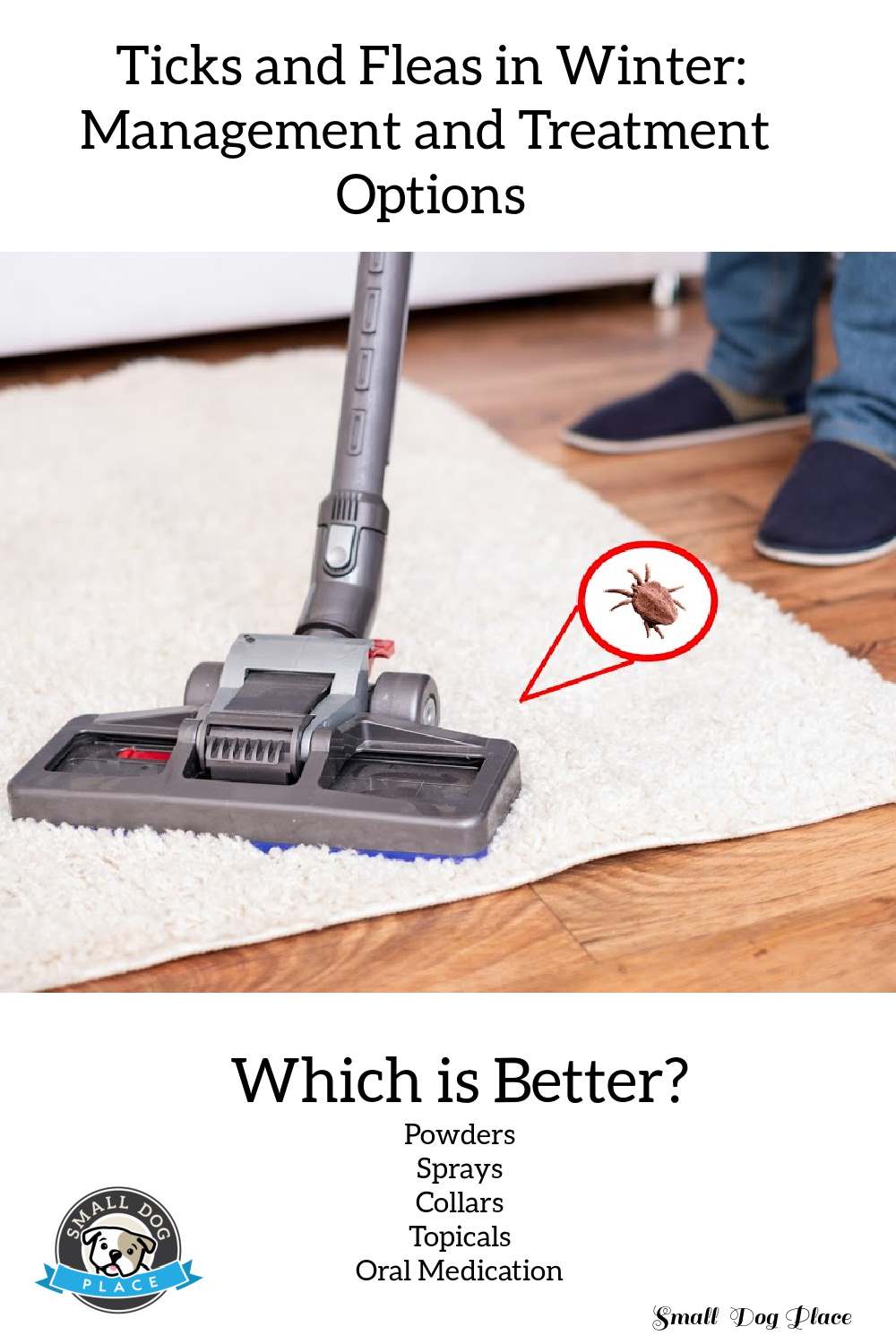Fleas in Winter: Protect Your Dog From These Pesky Parasites
Fleas in Winter by Karole King |Published 11-16-2020
Although fleas and ticks are most active during the warmer months (starting in March in some states in the U.S.), the American Kennel Club warns that they are a threat to pets all year round.
Ticks, in particular, can be very dangerous, transmitting a plethora of diseases - including Lyme disease, ehrlichiosis, and tick paralysis.
 Ticks and fleas in winter can be just as bothersome to your pet as those you may encounter at other times during the year.
Ticks and fleas in winter can be just as bothersome to your pet as those you may encounter at other times during the year.Fleas, meanwhile, can cause flea bite dermatitis in your small
dog, causing their skin to develop crusty lesions that itch, cause pain, and
result in the loss of firmness.
Fleas can also transmit parasites like tapeworm, which do not generally cause serious health problems in adult dogs but can affect puppies severely. Indeed, puppies infected with tapeworm can experience anemia, intestinal blockage, and lack of growth.
If you have a small dog, why is year-round treatment essential, what signs of flea or tick infestation should you be on the lookout for, and what options for treatment are available?
Fleas And Ticks Can Survive In The Winter
Ticks thrive in regions with warm, humid weather, and they are most abundant in areas like forests, shrubs, and undergrowth, regardless of the climate. While they generally aren’t active below 45ºF, they can survive the coldest months by finding warmer, covered spots to nestle in.
Fleas, meanwhile, can live in temperatures as low as 30ºF. Flea pupae are well protected in their cocoon, and they can remain dormant for months, even in the snow. When the warmer months arrive, they break free from their cocoons, wreaking havoc as adult fleas. This means that they can be ready to attack your small dog before you start seeing them as a potential problem.
 Fleas in winter can still transmit diseases to people.
Fleas in winter can still transmit diseases to people.Fleas And Ticks Can Transmit Disease To Humans
Fleas and ticks can harm human health in many ways. Fleas, for instance, can cause typhus, which can be fatal if left untreated. This disease is not common in the U.S., but it can be contracted abroad.
Other diseases include tapeworm (caused by fleas), rocky mountain spotted fever (caused by ticks), and ehrlichiosis (caused mainly by the lone star tick).
To prevent these diseases, you should not only treat your small dog but also take other steps such as cleaning up dog poop from your yard daily, frequently vacuuming, keeping your lawn well maintained, and wearing long sleeves and pants when spending time outdoors.
Signs And Symptoms Of Flea And Tick Infestations In Dogs
It is possible to see fleas and ticks on your small dog, even if you have applied the appropriate treatment. This is because treated fleas become more hyperactive before they die, and it takes around 24 hours for the treatment to kill them.
Fleas in winter can also be hatching at the time you treat your dog, so you may see new fleas on their coat. Dogs can also pick up fleas and ticks outside - for instance, if they spend time in a garden or forest. Regular treatment will ensure, of course, that they are no longer a problem within 24 hours.
Signs your pooch has fleas include intense scratching (since
fleas cause extreme itching), licking, and chewing. Some dogs do not partake in
scratching; instead, they
display more subtle signs - including appearing depressed, grumpy, or
restless. Other dogs simply behave strangely in normal situations.
Symptoms Of Tick Infestations In Dogs
Ticks are easier to spot than fleas since they are larger and tend to accumulate in more visible areas - including the ears and paws. Symptoms to watch out for include red and inflamed skin, lethargy, loss of appetite, lameness, and fever.
The latter are severe and more unusual symptoms. When they are present, they may indicate your dog has Lyme disease. If you find ticks, you should research how to remove them well (the whole tick can be removed with a tick hook).
If you think that you have left the mouthparts behind, contact
your vet since they can increase infection risk. A vet trip is always ideal
since a professional may find ticks that you have missed. Treatment will also
kill ticks in a matter of hours.
Fleas in Winter: Treatment Options
There is a wide array of flea and tick control products available, most of which fall into one of three categories. The first is topical flea and tick medications - these include spot-on treatments, shampoos, powders, and the like.
Powders have a short life (of about a week), so these are ideal only if you have the time and interest in weekly reapplications. Shampoos last for just 24 hours or so. Because of their short duration, both powders and shampoos are best combined with other treatments.
Topical treatments, meanwhile, last for around a month and are considered highly effective. Not all spot-on treatments are identical. Some also kill heartworms, so it is important to speak to your veterinarian so they can recommend a medication that deals with various potential issues at once.
Oral Medication And Flea And Tick Parasites
Flea pills are also effective at killing parasites, but they typically target either adult fleas or flea eggs, and they may have side effects. NBC News recently reported that flea pills containing a component called isoxazoline have been linked to adverse reactions, including ataxia and seizures.
Another option is flea and tick collars, which can provide protection for up to eight months. They emit a strong smell and contain high amounts of flea and tick poison, which makes them unsuitable for pregnant or nursing bitches and senior dogs or very young puppies.
Once again, consult with your vet regarding the suitability of this option. Flea and tick collars are very popular because they last so long, they are water-resistant, and they are reasonably priced.
However, if your small dog is allowed on the sofa or your bed, then you may find the smell emitted by the collar too strong to make it feasible. Some dogs are uncomfortable wearing collars; others find the spot-on treatment harsh, rubbing their skin against the grass or home furniture because they may have an allergic reaction to the treatment.
Skin reactions from spot-on products can range from tingling to chemical burns on sensitive skin, so it is vital to spot test any treatment before application.
Fleas and ticks proliferate in the summer, but they can definitely survive even the coldest winters, which is why year-long treatment is vital. Fleas and ticks not only cause skin and other problems for your dogs, but they can also harm human health.
Even if you treat your dogs year-round, you should be on guard for signs and symptoms such as itching, skin inflammation and redness, and behavioral changes. This is because flea pupae can survive in their cocoon for several months.
The good news is that treatment kills fleas and ticks in hours, meaning that even if your dog should be exposed to these pests, they are not likely to live for longer than a few hours. There are many treatment options for dogs, the most secure of which are spot-on treatments and flea and tick collars.
These are the longest-lasting treatment options, but some people prefer other treatment types because collars tend to have a strong smell. Speak to your vet about the best options for your small dog, ensuring you take additional precautions if you spend a considerable amount of time outdoors.
Fleas in Winter Pin for Future Reference
Fleas in Winter Author Bio
Karole is animal lover who has dedicated her life to helping dogs to find a safe and happy home. She now works as a freelance writer, which is her passion, and has the freedom to spend more time at home with her wonderful family.
Other Articles by Karole King
6 Signs Your Shih Tzu is Overweight
Improve Indoor Air Quality: Could the Air In Your Home Make Your Dog Sick?
Traveling With Small Dogs: Tips for a Safe Trip
About Janice (author and voice behind this site)
Janice Jones has lived with dogs and cats for most of her life and worked as a veterinary technician for over a decade. She has also been a small-breed dog breeder and rescue advocate and holds academic training in psychology, biology, nursing, and mental health counseling. Her work focuses on helping dog owners make informed, responsible decisions rooted in experience, education, and compassion.
When not writing, reading, or researching dog-related topics, she likes to spend time with her six Shih Tzu dogs, her husband, and her family, as well as knitting and crocheting. She is also the voice behind Miracle Shih Tzu and Smart-Knit-Crocheting
Does This Article Deserve Your Thumbs Up?
We always appreciate your support and encouragement. Your thumbs up means so much to us. Please like this article.
If you find this page or any page on Small Dog Place Helpful, or useful in anyway, I'd love it if you would click the small heart found on the bottom right of each page.
You can also share or bookmark this page -- just click on the:

Free Monthly Newsletter
Sign Up for Our Free Newsletter and get our Free Gift to You.
my E-book, The Top 10 Mistakes People Make When Choosing a Dog (and how to avoid them)





